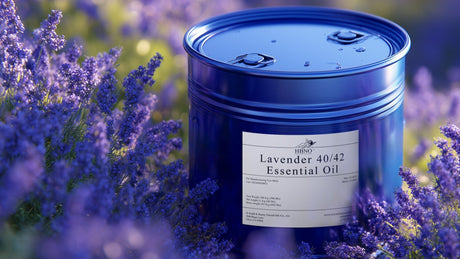In the world of natural skincare, few ingredients rival the reputation of rosehip seed carrier oil. Extracted from the seeds of Rosa canina, this golden oil is celebrated for its ability to nourish and revitalize the skin.
Packed with essential fatty acids, vitamins A and C, and antioxidants, rosehip seed oil benefits include improved hydration and a more even skin tone. As a carrier oil-not an essential oil-it can be used directly on the skin, making it a trusted choice for natural moisturization.
Rosehip Oil Benefits for Skin
When looking for a natural way to support and rejuvenate the skin, rosehip oil delivers a powerhouse of benefits:
1. Intense Hydration
Rosehip seed oil contains essential fatty acids, such as linoleic acid and linolenic acid, which may help to lock in moisture and strengthen the skin's barrier. These fatty acids are crucial for keeping skin soft, supple, and well-hydrated.
2. Anti-Aging Support
Vitamin A (a natural form of retinol) and vitamin C are abundant in rosehip oil. These nutrients may help stimulate collagen production and improve skin elasticity. Regular use may minimize fine lines and wrinkles, offering a natural, non-irritating alternative to synthetic anti-aging treatments. Rosehip oil stands as one of the best essential oils for anti- aging.
3. Brightening and Evening Skin Tone
If you're dealing with dull skin or uneven pigmentation, rosehip oil may be a game changer. Its vitamin A content may help boost cell turnover, while vitamin C works to fade dark spots and discoloration.
4. Scar and Stretch Mark Reduction
One of the most talked-about rosehip oil benefits may be its ability to reduce the appearance of scars and stretch marks. The oil's regenerative properties may support skin repair and tissue healing. With consistent use, many users notice smoother skin and a visible fading of old scars.
5. Anti-Inflammatory Properties
Thanks to antioxidants and polyphenols, rosehip seed oil may calm inflammation. It's a great natural remedy for irritated skin.

How to Use Rosehip Seed Oil as Moisturizer
If you're new to carrier oils, incorporating rosehip seed oil as moisturizer into your routine is easy and effective. Here's how to make the most of this botanical gem:
Step 1: Start with Clean Skin
Always apply rosehip oil to freshly cleansed skin. Use a gentle cleanser that suits your skin type, and pat your face dry with a clean towel.
Step 2: Apply Directly or Mix with Moisturizer
You have two main options:
-
Direct Application: Dispense 2-3 drops of rosehip seed oil into your palm. Warm it between your fingers and gently press it into your skin, focusing on dry areas or zones of concern. You can use it on your entire face and neck.
-
Mix with Moisturizer: Add a few drops to your favorite facial moisturizer and apply the blend. This method helps enhance your current cream's hydration power while delivering the nutrients of rosehip oil.
Step 3: Use Twice Daily or As Needed
For best results, apply rosehip oil in the morning and at night. It layers well under sunscreen or makeup, making it versatile for both day and nighttime routines. Its quick absorption means no greasy residue-just a healthy glow.
Step 4: Layer It Right in Your Routine
When combining rosehip oil with other personal care and cosmetics products, apply it after water-based serums but before any heavy creams or facial oils. This allows it to lock in hydration without blocking the absorption of active ingredients.
Safety Tips for Using Rosehip Seed Oil
While rosehip seed oil is generally considered safe for most skin types, here are some precautions to follow to ensure the best experience:
1. Perform a Patch Test
Before using any new oil on your face, do a patch test. Apply a small amount to the inside of your arm or behind your ear and wait 24 hours. If you notice any redness, itching, or irritation, discontinue use.
2. Store Properly
Because of its high fatty acid content, rosehip oil is sensitive to light and heat. Store your bottle in a cool, dark place (or even the refrigerator) to extend its shelf life and prevent rancidity.
3. Watch for Allergic Reactions
Although rare, allergic reactions can happen. If you're allergic to rose plants or products, consult with a healthcare provider before applying rosehip oil to your skin.
4. Don't Use as a Sunscreen Substitute
While rosehip oil benefits include antioxidants that can help protect against sun damage, it should never replace sunscreen. Always apply SPF after using rosehip oil if you're heading outdoors.
5. Know the Difference: Rosehip Oil vs. Rosehip Essential Oil
Many people confuse rosehip essential oil with rosehip seed oil. The essential oil is a concentrated extract that must be diluted before topical use and is typically used in aromatherapy. Rosehip seed oil, on the other hand, is a nourishing carrier oil meant for direct application. Always read the label to ensure you're using the correct product.
Final Thoughts: Why You Should Try Rosehip Seed Oil
For a natural, effective, and affordable way to achieve glowing, hydrated skin, rosehip seed oil is a top choice. Rich in vitamins, antioxidants, and essential fatty acids, it helps reduce fine lines, fade scars, and even out skin tone-without clogging pores or causing irritation.
Simple to use and gentle on the skin, rosehip seed oil delivers visible results within weeks. For best results, opt for cold-pressed, organic oil-and always patch test first. Discover the power of nature's moisturizer with high-quality rosehip seed oil from HBNO bulk.




